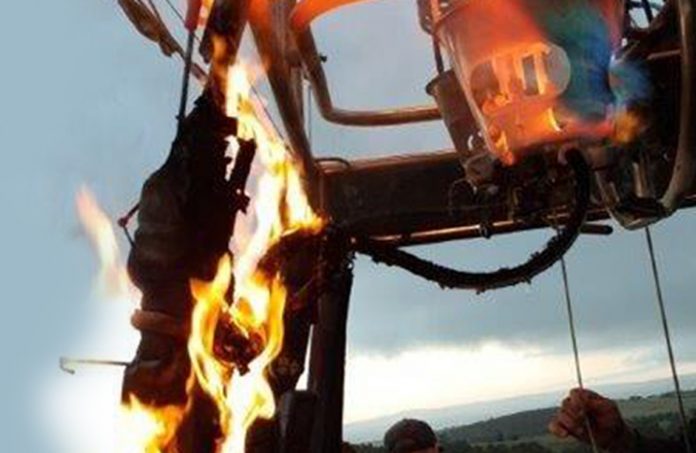A circular handle may have contributed to a fire on a hot air balloon that led to its destruction, an Australian Transport Safety Bureau investigation has found. Fortunately, the crash caused only one minor physical injury. A traumatised passenger was taken to hospital for observation.
The sightseeing balloon with one pilot and 15 passengers caught fire about 20 minutes after taking off from Wandin, north-east of Melbourne on 26 December last year. About 20 minutes into the flight there was a small explosion in the front left burner that started a small fire on the burner. The pilot switched off the vapour valve at the fuel tanks to the front two burners and disconnected the hoses. The pilot discharged a fire extinguisher but the fire relit – twice.
After about eight minutes of unsuccessful firefighting, the pilot identified a suitable landing place and began the approach. During the descent, the basket struck treetops, which injured a passenger’s hand. Ropes from the balloon became tangled in the treetops and had to be untangled by the pilot. As the basket touched the ground, the passengers on one side jumped out, lightening the balloon and causing it to lift off again. The pilot jettisoned hot air from the envelope and landed a second time.
The ATSB found the hand-wheel valve on the liquid outlet of the fuel tank and the pilot burners were not shut-off, which resulted in the pilot being unable to control the fire. The balloon had both liquid and vapour lines connected to the liquid propane tank. The vapour line fed gaseous propane to the pilot burner and the liquid line fed liquid propane direct to the burner coil.
ATSB executive director transport safety Nat Nagy said, ‘Pilots experience a high workload during in-flight emergencies. However, in the event of an in‑flight balloon fire, the first priority must be isolation of the fuel supply at the fuel tank.’
‘In addition, it is good practice to rehearse emergency procedures by standing in the basket to run through the checklist steps.’
The ATSB said installation of a lever-type 90-degree valve on the liquid fuel outlet may have helped the pilot recognise that the liquid fuel valve was not shut-off. A 90-degree valve has the advantages of quick operation and indication of its position. Human factors, often thought of as a discipline purely concerned with interaction between people, extends to flight deck and system design.
CASA issued Airworthiness Bulletin 02-063 in January 2019, to address some of the issues the event had raised. The bulletin includes:
- a recommendation to inspect critical components
- the use of 90-degree shut-off valves for the fuel tank liquid outlets
- a reminder to close off liquid and vapour valves in the event of a fire
- a reminder to wear appropriate personal protective equipment.
The operator, Go Wild Ballooning, has advised the ATSB that it has replaced all hand-wheel valves with 90-degree valves on all fuel tanks and reviewed the company policy on protective clothing.



Gee, now I know why you would never find me in these flying death traps! Very lucky they where!
You wouldn’t get me in one either, even at gunpoint!
I might do it with my parachute on. :D
Richard Branson don’t seem to have a problem risking his life. Thrill seeker.